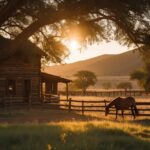Phoenix, Arizona, boasts prime locations for birdwatching, catering to a diverse range of avian enthusiasts. Whether you’re drawn to the tranquil serenity of wetland habitats or the rugged beauty of desert landscapes, Phoenix offers an array of destinations promising unforgettable birdwatching experiences. The Tres Rios Wetlands, situated on the city’s southwestern edge, emerges as a premier spot for birdwatching. This extensive network of restored wetlands and riparian habitats serves as vital stopover points for migratory birds traversing the Pacific Flyway. Birdwatchers revel in spotting a kaleidoscope of species, from elegant waterfowl gracefully gliding across serene ponds to elusive marsh birds hidden among the cattails. Accessible trails and viewing platforms make the Tres Rios Wetlands an ideal locale for immersing oneself in the splendor of bird watching.
Adjacent to Phoenix, the Tres Rios Wetlands boasts a verdant sanctuary teeming with birdlife. Here, expansive marshlands provide refuge for migratory waterfowl and resident species alike. The rustle of reeds accompanies the melodious trill of songbirds, creating a serene backdrop for observation and contemplation. Further afield, the McDowell Sonoran Preserve offers rugged trails and panoramic vistas, where hikers may encounter majestic raptors soaring overhead or elusive desert dwellers darting among the cacti.
In addition to birdwatching, visitors to Phoenix can indulge in a wealth of outdoor activities. Kayak along the serene waters of the Salt River, where herons and egrets wade in search of sustenance. Embark on a guided desert botanical tour to uncover the intricate relationships between native flora and the avifauna they support. For a glimpse into the cultural heritage of the region, explore the Heard Museum, which showcases indigenous art and artifacts alongside exhibits highlighting the interconnectedness of humans and nature.
Whether you’re captivated by the iridescent plumage of a hummingbird or the stoic presence of a great horned owl, Phoenix offers an immersive experience for birdwatchers of all interests and skill levels. With its diverse array of habitats, nearby attractions, and opportunities for exploration, the city beckons nature enthusiasts to spread their wings and embark on an unforgettable avian adventure.
Table of Contents
Biodiversity Hotspot
Phoenix, Arizona stands as an unexpected biodiversity hotspot amidst its arid surroundings. Despite the seemingly inhospitable desert landscape, this vibrant city boasts an astonishing array of bird species, making it a haven for ornithologists and nature lovers alike. From the iconic saguaro-studded Sonoran Desert to the lush riparian corridors that wind through urban parks, Phoenix offers a diverse tapestry of habitats that support an impressive diversity of avian life.
The Tres Rios Wetlands, situated just south of the city, exemplifies Phoenix’s status as a biodiversity hotspot. This sprawling complex of restored marshlands serves as a critical stopover point for migratory birds traversing the Pacific Flyway. Here, visitors may spot elegant herons poised along the water’s edge, colorful warblers flitting among the reeds, or majestic raptors circling overhead. The juxtaposition of bustling urban life and thriving wildlife habitat underscores Phoenix’s commitment to conservation and environmental stewardship.
Beyond the wetlands, the McDowell Sonoran Preserve offers a glimpse into the rugged beauty of the Sonoran Desert. Spanning over 30,000 acres of pristine wilderness, this protected area provides refuge for a myriad of desert-adapted species, from the diminutive cactus wren to the elusive elf owl. Trails wind through towering saguaros and ancient rock formations, offering opportunities for birdwatchers to observe the unique adaptations that enable desert birds to thrive in this harsh environment.
In addition to its natural wonders, Phoenix is also home to a wealth of cultural attractions that celebrate the region’s rich biodiversity. The Desert Botanical Garden showcases the remarkable diversity of desert plants, many of which provide crucial habitat and food sources for native birds. Meanwhile, the Phoenix Zoo offers immersive exhibits featuring exotic birds from around the world, highlighting the interconnectedness of ecosystems on a global scale.
As climate change and habitat loss threaten avian populations worldwide, the importance of preserving biodiverse hotspots like Phoenix cannot be overstated. By protecting and restoring critical habitats, promoting sustainable land management practices, and fostering a culture of environmental stewardship, Phoenix continues to serve as a shining example of how cities can coexist harmoniously with nature while nurturing biodiversity for generations to come.
Prime Birding Locations
Phoenix, Arizona, is blessed with prime birding locations that cater to a diverse range of avian enthusiasts. Whether you’re seeking the tranquil serenity of wetland habitats or the rugged beauty of desert landscapes, Phoenix offers an array of destinations that promise unforgettable birdwatching experiences.
The Tres Rios Wetlands, located on the city’s southwestern edge, stands out as a premier birding destination. This expansive network of restored wetlands and riparian habitats provides vital stopover points for migratory birds traveling along the Pacific Flyway. Here, birdwatchers can spot a kaleidoscope of species, from elegant waterfowl gliding across serene ponds to elusive marsh birds concealed among the cattails. With well-maintained trails and viewing platforms, the Tres Rios Wetlands offer both accessibility and immersion in nature’s splendor.
For those drawn to the rugged allure of desert landscapes, the McDowell Sonoran Preserve beckons with its untamed beauty. Spanning thousands of acres of pristine wilderness, this protected area harbors a wealth of desert-adapted birds amidst towering saguaros and rocky outcrops. Hiking trails wind through diverse habitats, offering birdwatchers the chance to encounter iconic species such as the Greater Roadrunner, Gila Woodpecker, and Gambel’s Quail. As the sun sets over the desert horizon, the preserve comes alive with the haunting calls of nocturnal birds, adding an extra layer of enchantment to the birding experience.
In addition to these natural gems, urban parks within Phoenix provide accessible and rewarding birding opportunities. Papago Park, with its scenic desert vistas and tranquil lagoons, attracts a variety of waterfowl and songbirds throughout the year. Meanwhile, the riparian corridors of Rio Salado Habitat Restoration Area offer a respite for migratory birds amidst the bustle of city life, showcasing the power of habitat restoration in creating thriving ecosystems within urban environments.
Whether you’re a seasoned birder or a novice enthusiast, Phoenix’s prime birding locations offer something for everyone. With their diverse habitats, abundant wildlife, and opportunities for exploration, these destinations invite visitors to connect with nature and experience the wonder of avian life in the desert Southwest.
Bird Species in Phoenix
Birdwatching in Phoenix offers an extraordinary opportunity to encounter a diverse array of avian species against the backdrop of the city’s stunning desert landscapes. From iconic desert dwellers to migratory visitors, Phoenix’s prime birding locations host a rich tapestry of winged wonders that captivate enthusiasts of all levels. Whether you’re exploring wetland habitats teeming with waterfowl or traversing rugged desert trails in search of elusive species, each bird holds a story waiting to be discovered.
Species:
- Gambel’s Quail: These charismatic ground-dwellers are a common sight in the desert scrublands of Phoenix, distinguished by their distinctive plumes and intricate calls. Often seen scurrying across sandy washes or perched atop prickly pear cacti, Gambel’s Quail are skilled runners and agile climbers, adept at navigating the rugged terrain.
- Cactus Wren: With its striking black and white markings and distinctive song, the Cactus Wren is a quintessential desert species found throughout Phoenix’s arid landscapes. Nesting among thorny shrubs and cacti, these adaptable birds are known for their resourcefulness and resilience in the harsh desert environment.
- Gila Woodpecker: Recognizable by its bold black and white plumage and vibrant red cap, the Gila Woodpecker is a frequent visitor to saguaro cacti, where it excavates nesting cavities in search of insects and sap. Its rhythmic tapping echoes through the desert as it forages for food and communicates with other members of its species.
- Greater Roadrunner: A symbol of the American Southwest, the Greater Roadrunner is a master of speed and stealth, darting among mesquite trees and rocky outcrops in search of prey. With its distinctive long tail and crest of feathers, this iconic bird is both a predator and a scavenger, preying on insects, lizards, and small mammals.
- Verdin: With its bright yellow plumage and energetic demeanor, the Verdin adds a splash of color to Phoenix’s desert landscapes. These tiny songbirds are often seen flitting among desert shrubs and trees, weaving intricate nests from twigs and plant fibers high above the ground.
- Cooper’s Hawk: A formidable predator of the avian world, the Cooper’s Hawk is a sleek and agile hunter that patrols the skies above Phoenix in search of prey. With its keen eyesight and lightning-fast reflexes, this raptor specializes in capturing small birds and mammals in mid-flight, employing stealth and surprise to secure its next meal.
From the majestic saguaros of the Sonoran Desert to the lush riparian corridors of urban parks, Phoenix’s diverse habitats provide a haven for an astonishing variety of bird species. Whether you’re marveling at the colorful plumage of a Vermilion Flycatcher or admiring the stealthy prowess of a Cooper’s Hawk, each bird offers a glimpse into the intricate web of life that thrives in the desert Southwest. With its abundance of species and unparalleled natural beauty, Phoenix invites birdwatchers to embark on an unforgettable journey of discovery and connection with the avian world.
Seasonal Highlights
Seasonal highlights in Phoenix’s birdwatching calendar offer a dynamic tapestry of avian activity year-round, ensuring there’s never a dull moment for bird enthusiasts. Each season brings its own unique spectacles, from the flurry of migratory birds during spring and fall to the captivating nesting behaviors observed in summer and the diverse array of wintering species that seek refuge from colder climates.
Spring heralds the arrival of migratory birds as they journey northward, transforming the desert landscape into a bustling thoroughfare of avian activity. Flocks of colorful warblers, tanagers, and orioles fill the air with their melodious songs, while raptors such as hawks and falcons soar overhead in search of prey. Wetland habitats, such as the Tres Rios Wetlands, become staging grounds for waterfowl and shorebirds preparing for their long journey ahead, offering prime opportunities for birdwatchers to observe a diverse array of species in migration.
As temperatures rise and summer takes hold, Phoenix’s resident bird species enter their breeding season, showcasing an array of captivating nesting behaviors. From the acrobatic courtship displays of hummingbirds to the intricate nest-building efforts of songbirds, the desert landscape comes alive with the sights and sounds of avian courtship. Birdwatchers may glimpse the adorable sight of fledglings taking their first flights or the vigilant parental care exhibited by nesting birds as they protect their young from predators.
Come fall, the cycle of migration begins anew as birds make their return journey southward, once again passing through Phoenix on their way to warmer wintering grounds. Wetland habitats teem with activity as waterfowl and shorebirds gather in preparation for their long journey ahead, offering birdwatchers a final opportunity to witness the spectacle of migration before the arrival of winter.
Winter brings its own delights to Phoenix’s birdwatching scene, as a variety of wintering species seek refuge in the city’s temperate climate. From elegant Sandhill Cranes congregating in agricultural fields to colorful migratory songbirds seeking shelter in urban parks, winter offers a diverse array of avian visitors for birdwatchers to enjoy. As the desert landscape takes on a tranquil beauty, birdwatchers can take advantage of the cooler temperatures to explore Phoenix’s prime birding locations and observe the rich diversity of wintering species that call the city home during the colder months.
Throughout the year, Phoenix’s seasonal highlights offer a captivating glimpse into the dynamic world of avian life in the desert Southwest. Whether you’re marveling at the spectacle of migration, witnessing the wonders of nesting season, or enjoying the diversity of wintering species, each season brings its own unique rewards for birdwatchers to savor and enjoy.
Conservation Efforts
Conservation efforts in Phoenix, Arizona, play a pivotal role in preserving the city’s rich biodiversity and ensuring the long-term survival of its avian inhabitants. As urbanization encroaches upon natural habitats and climate change poses new challenges, local organizations and initiatives have stepped up to protect and restore critical ecosystems, fostering a harmonious relationship between humans and wildlife.
One notable conservation success story is the restoration of the Tres Rios Wetlands, a sprawling complex of marshlands and riparian habitats on the city’s southwestern edge. Once degraded by urban runoff and agricultural pollution, this vital ecosystem has undergone a remarkable transformation thanks to collaborative efforts between government agencies, non-profit organizations, and community volunteers. Through habitat restoration, water quality improvement, and invasive species management, the Tres Rios Wetlands now serve as a haven for migratory birds, native wildlife, and outdoor enthusiasts alike.
Beyond wetland restoration, conservation efforts in Phoenix extend to the preservation of desert habitats and urban green spaces. The McDowell Sonoran Preserve, spanning thousands of acres of pristine wilderness, protects critical habitat for a diverse array of desert-adapted species, from iconic saguaros to elusive desert mammals. Through land acquisition, trail management, and public outreach, the preserve ensures that future generations can continue to enjoy the natural beauty of the Sonoran Desert while safeguarding its ecological integrity.
In addition to habitat preservation, education and outreach play a vital role in promoting conservation awareness and stewardship among local communities. Environmental education programs, guided nature walks, and citizen science initiatives empower residents to become active participants in protecting their natural heritage. By fostering a sense of connection to the land and instilling a respect for wildlife and wild places, these efforts cultivate a culture of conservation that transcends generations.
As climate change poses new threats to biodiversity, the need for proactive conservation action has never been greater. By supporting habitat restoration, land conservation, and environmental education initiatives, Phoenix is taking proactive steps to address the challenges facing its avian inhabitants and ensure a sustainable future for both wildlife and humans alike. Through collaboration, innovation, and community engagement, the city is paving the way for a brighter tomorrow where nature thrives, and birds continue to enchant and inspire generations to come.
Tips for Birdwatchers
For birdwatchers venturing into the vibrant landscapes of Phoenix, Arizona, a successful outing hinges on preparation, patience, and a keen eye for detail. Whether you’re a seasoned birder or a novice enthusiast, these tips will help you make the most of your birdwatching adventure in the desert Southwest.
- Gear Up: Before setting out, make sure you have the essential gear for birdwatching. A pair of high-quality binoculars will enhance your ability to spot and identify birds from a distance, while a field guide specific to the region can help you identify unfamiliar species. Don’t forget to dress appropriately for the desert climate, with lightweight, breathable clothing, a wide-brimmed hat, and plenty of sunscreen to protect against the sun’s rays.
- Choose the Right Time: Birds are most active during the early morning and late afternoon hours when temperatures are cooler and food sources are plentiful. Plan your birdwatching excursions accordingly, and aim to arrive at your chosen location during peak feeding times to maximize your chances of spotting a variety of species.
- Know Your Habitat: Phoenix boasts a diverse array of habitats, from desert scrublands to riparian corridors and urban parks. Familiarize yourself with the habitats favored by different bird species, and choose locations that offer the best chance of encountering your target birds. Wetlands, such as the Tres Rios Wetlands, are ideal for waterfowl and shorebirds, while desert preserves like the McDowell Sonoran Preserve are home to a variety of desert-adapted species.
- Practice Patience: Birdwatching requires patience and perseverance, as birds can be elusive and may take time to reveal themselves. Take your time to observe your surroundings quietly, listening for the calls and songs of nearby birds and scanning the landscape for movement. Be prepared to wait patiently for birds to emerge from cover or return to a favored feeding area, and avoid making sudden movements that could startle them.
- Respect Wildlife and Habitat: Remember that you are a guest in the birds’ home, and treat the natural world with respect and reverence. Stay on designated trails to minimize disturbance to nesting birds and fragile habitats, and avoid getting too close to birds or their nests. Practice responsible birdwatching etiquette by refraining from playing recorded bird calls, which can disrupt natural behaviors and stress out birds.
- Keep Records: Bring along a notebook or smartphone to record your bird sightings and observations, including the species you’ve seen, the time and location of your sightings, and any interesting behaviors you’ve observed. Keeping a birding journal can help you track your progress, identify patterns in bird activity, and contribute valuable data to citizen science projects.
By following these tips and embracing the spirit of exploration and discovery, birdwatchers can embark on a rewarding journey through the diverse landscapes of Phoenix, Arizona, and connect with the rich tapestry of avian life that calls the desert Southwest home.
Conclusion
In conclusion, birdwatching in Phoenix, Arizona, offers a gateway to the wonders of the natural world, where the city’s vibrant landscapes serve as a backdrop for unforgettable avian encounters. From the tranquil wetlands teeming with migratory waterfowl to the rugged desert preserves echoing with the calls of desert dwellers, Phoenix’s prime birding locations provide a sanctuary for both birds and birdwatchers alike. Through conservation efforts, habitat restoration, and a commitment to environmental stewardship, the city has emerged as a shining example of how urban centers can coexist harmoniously with nature, preserving biodiversity for future generations to enjoy.
As visitors and residents alike flock to Phoenix’s prime birding destinations, they embark on a journey of discovery and connection, forging bonds with the natural world that transcend boundaries and unite us in our shared love for birds and wild places. Whether marveling at the intricate plumage of a hummingbird, witnessing the majesty of a soaring raptor, or simply savoring the peace and tranquility of a desert sunrise, birdwatchers in Phoenix are rewarded with moments of wonder and awe that reaffirm our deep-seated connection to the web of life that surrounds us. So, pack your binoculars, lace up your hiking boots, and join us in exploring the diverse avian wonders of Phoenix, Arizona – where every bird brings a story, and every sighting is a moment to cherish.







